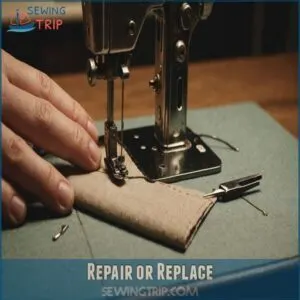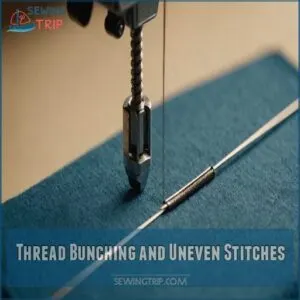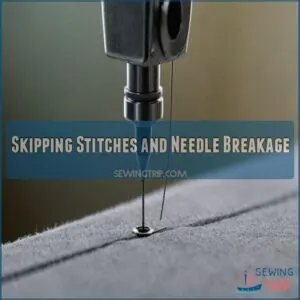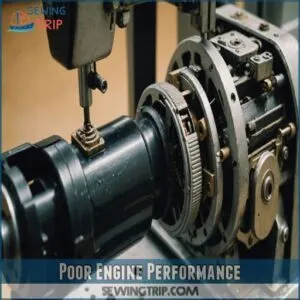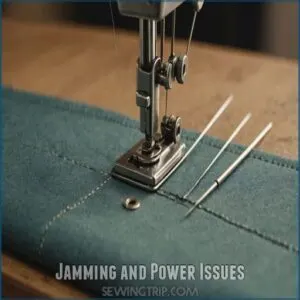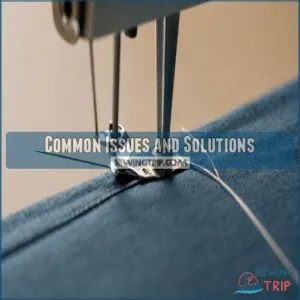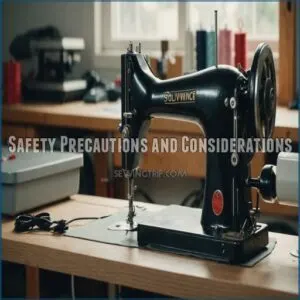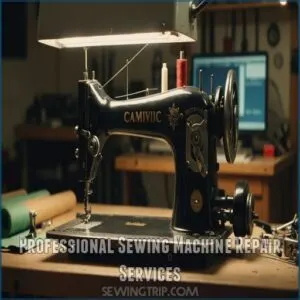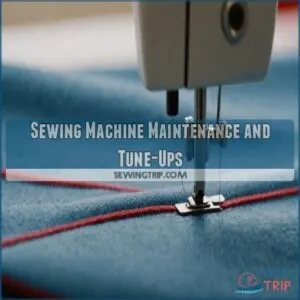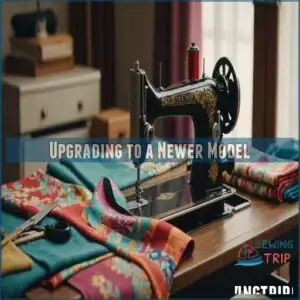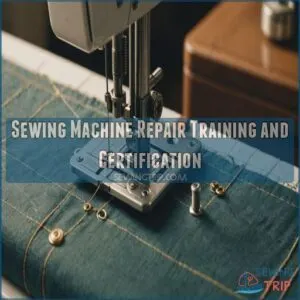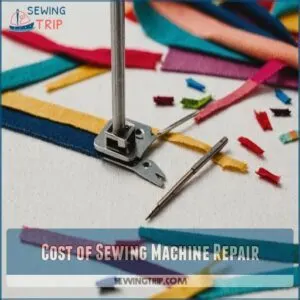This site is supported by our readers. We may earn a commission, at no cost to you, if you purchase through links.

Is your machine skipping stitches? Check the needle and bobbin. Thread bunching? Clean the bobbin area.
A little preventative maintenance goes a long way. Regular lubrication and cleaning prevent bigger issues.
Knowing the basics of sewing machine repair can save you money and frustration. We’ll show you how to diagnose problems quickly.
You’ll be amazed at what you can fix yourself. Discover simple solutions for even the trickiest sewing machine repairs.
Table Of Contents
- Key Takeaways
- Repair or Replace
- Common Sewing Machine Problems
- DIY Sewing Machine Repairs
- Professional Sewing Machine Repair Services
- Sewing Machine Maintenance and Tune-Ups
- Upgrading to a Newer Model
- Sewing Machine Repair Training and Certification
- Cost of Sewing Machine Repair
- Frequently Asked Questions (FAQs)
- Conclusion
Key Takeaways
- You’ll save money and frustration by learning basic sewing machine troubleshooting, like fixing thread bunching and skipped stitches.
- Regular maintenance, such as lubrication and cleaning, prevents major issues and extends your machine’s lifespan.
- Weigh the cost of repairs against a new purchase, especially if repairs exceed $75 for machines under $200.
- Know when to DIY and when to enlist a professional, especially for complex repairs involving motors or timing mechanisms.
Repair or Replace
You’ll face a tough choice when your sewing machine breaks down. Weigh repair costs against buying new to make the smart call for your wallet and crafting needs.
Weighing The Cost of Repairs
When your trusty sewing machine acts up, you’re faced with a stitch-y situation: repair or replace? Here’s how to thread the needle on this decision:
- Check the price tag: Is your machine worth more than $200?
- Crunch the numbers: Compare repair costs to new machine prices
- Consider age: Vintage machines might lack parts
- Factor in location: Repair costs vary by area
Don’t let repair costs unravel your budget. Weigh these factors to make the right choice.
Assessing The Severity of Damage
Faced with a broken sewing machine, you’ll need to assess the damage.
Is it a quick fix or a major overhaul?
Let’s break it down:
| Severity | Signs | Action |
|---|---|---|
| Minor | Jammed thread, loose screws | DIY repair |
| Moderate | Skipped stitches, tension issues | Professional tune-up |
| Severe | Burnt motor, broken gears | Consider replacement |
| Critical | Multiple failures, outdated model | Time for an upgrade |
If you’re considering a repair, weigh the cost against the machine’s overall value and age, as outlined in a detailed guide.
Evaluate the problem, weigh repair costs, and decide if it’s worth fixing or time to replace.
Considering The Initial Cost of The Machine
The initial cost of your sewing machine plays a big role in the repair-or-replace decision.
If you’re dealing with a basic machine, you might find that the price of a new sewing machine, especially at the lower end of the price range like check out sewing machine prices, makes it more economical to simply buy a new one.
Got a budget model under $200? It might be smarter to buy new.
Higher-end machines warrant repair investments.
Compare repair costs to the price of a new machine.
Factor in age and features too.
Sometimes, an upgrade’s the way to go.
It’s all about getting the most bang for your buck.
Determining The Feasibility of Repair
You’ve got a broken sewing machine. Now what? Before you toss it, let’s figure out if it’s worth fixing.
Consider these factors:
- Repair cost vs. machine value
- Age and parts availability
- Severity of damage
- DIY potential vs. pro repair
Weigh these carefully.
Sometimes, a quick fix can breathe new life into your trusty stitcher.
Other times, it’s smarter to invest in a new model.
Trust your gut, but don’t be afraid to get a pro’s opinion.
Common Sewing Machine Problems
You’ll face common sewing machine issues like thread bunching and skipped stitches. These problems can frustrate you but they’re often fixable with the right know-how.
Thread Bunching and Uneven Stitches
Now let’s tackle thread bunching and uneven stitches. These pesky problems can turn your sewing project into a tangled mess.
Check your tension first – it’s often the culprit. If you’re struggling with tension issues, check out these helpful resources for sewing machine tension.
Rethread both top and bobbin threads.
Make sure you’re using the right needle for your fabric.
Clean out any lint hiding in the bobbin area.
Still having issues? Try adjusting your stitch length or switching to a different thread brand.
Skipping Stitches and Needle Breakage
Speaking of pesky problems, skipped stitches and broken needles often go hand-in-hand.
Check if you’re using the right needle type for your fabric – a ballpoint for knits or sharp for wovens.
Clean your bobbin area and adjust the tension.
If your needle keeps breaking, inspect for bent points or nicks.
Remember to change your needle after 8 hours of sewing.
Poor Engine Performance
Listen closely to your sewing machine motor – unusual sounds often signal trouble.
A healthy engine purrs like a content cat, but grinding or clunking noises mean it’s time for action.
Check the belt tension first – if it’s loose, tighten it.
Clean any debris around the motor housing.
If the engine still sounds off, apply sewing machine oil to the motor’s moving parts.
Jamming and Power Issues
Your sewing machine’s power hiccups and jamming issues don’t have to mean game over.
First, check your power cord for fraying or loose connections.
If you’re dealing with a jammed bobbin, remove the plate and clean out any trapped threads.
You’ll want to inspect the motor belt too – a loose or worn belt can cause both power and jamming problems.
Remember, unplug before investigating electrical issues.
DIY Sewing Machine Repairs
You can tackle many sewing machine problems without spending money on a repair service.
Before you reach for your wallet, try these proven DIY fixes that’ll help you identify and solve common issues like thread bunching, tension problems, and broken needles.
Common Issues and Solutions
A jammed bobbin often causes those pesky thread nests under fabric.
Fix it by removing and reinserting the bobbin correctly.
For skipped stitches, try swapping in a fresh needle – they get dull faster than you’d think!
Adjust tension dials gradually when threads break mid-stitch.
Clean the feed dogs with a brush when fabric sticks.
Most needle breakage happens from pulling fabric too hard.
Safety Precautions and Considerations
Safety comes first when tackling sewing machine repairs.
Always unplug the machine before starting any maintenance work.
Keep your work area well-lit and clutter-free for machine stability.
Wear eye protection when handling needles or small parts.
Store tools in a dedicated container to prevent accidents.
Clean hands reduce slip hazards when handling oil or lubricants.
A stable workbench prevents machine wobbles during repairs.
When to Seek Professional Help
Despite our can-do spirit, some sewing machine problems need professional expertise, often provided by factory-trained technicians.
Time to call a repair technician when you notice these warning signs:
- Unusual grinding noises or burning smells indicate major malfunctions
- Complex repairs involving electrical components or timing mechanisms
- Warranty concerns that DIY fixes might void
Don’t let pride get in the way – professional sewing machine service often saves money and prevents further damage
Professional Sewing Machine Repair Services
When your sewing machine needs expert care, professional repair services can help. They offer tune-ups, fix complex issues, and work on various brands and models.
Finding a Reliable Repair Technician
Sometimes, DIY fixes just won’t cut it.
To find a skilled sewing machine repair technician, start by asking fellow sewers for recommendations, or check your Local Yellow Pages.
Check online reviews and the shop’s reputation.
Look for experience with your machine’s brand.
Consider location and repair costs.
A great tech is worth their weight in thread – they’ll have your machine purring like new in no time.
Services Included in a Tune-Up
Once you’ve found a pro, let’s unpack what’s in a sewing machine tune-up.
It’s like a spa day for your trusty stitcher!
Here’s what you can expect:
- Thorough cleaning to banish lint and dust
- Bobbin check and tension adjustment for smooth sewing
- Lubrication of all moving parts
- Timing check to make sure perfect stitches
These services keep your machine purring like a kitten.
Regular tune-ups are key to extending your machine’s life and avoiding costly repairs down the road.
Brands and Models Serviced
You’ve got your tune-up sorted, now let’s talk brands.
Most repair shops handle popular sewing machine brands like Singer, Brother, and Janome.
They’re equipped to fix both mechanical and computerized models.
Check if your local technician services your specific machine.
Some specialize in vintage models or industrial machines.
Don’t forget to ask about warranty coverage for repairs.
It’s always good to know your options!
Sewing Machine Maintenance and Tune-Ups
Keep your sewing machine running smoothly with regular maintenance. Clean, oil, and tune up your machine to prevent costly repairs and guarantee perfect stitches every time.
Importance of Regular Maintenance
Regular maintenance is your sewing machine’s best friend.
Think of it as a spa day for your trusty stitching companion.
By giving it some TLC, you’ll keep it purring like a kitten and avoid costly repairs down the road.
A well-oiled machine lasts longer, sews smoother, and saves you money.
Set a reminder for monthly checkups – your future self will thank you for this stitch in time.
Removing Fluff, Dust, and Lint
Fluff, dust, and lint are your sewing machine’s worst enemies.
They sneak into every nook and cranny, causing mischief.
Grab your trusty lint brush and vacuum with a narrow nozzle.
Open your machine’s covers and gently sweep away debris.
Pay extra attention to the bobbin area and feed dogs.
This simple DIY maintenance keeps your machine purring like a well-oiled cat, ready for your next creative project.
Lubrication and Tension Checks
Now that your machine is dust-free, let’s keep things running smooth as silk. Proper lubrication and tension checks prevent those dreaded thread nests and wonky stitches. Think of it like giving your trusty machine a spa day – a few drops of oil in the right spots work wonders. Check the tension by testing stitches on scrap fabric first.
- Apply sewing machine oil only to moving metal parts
- Wipe away excess oil with a clean cloth
- Test upper tension by holding the thread tail
- Adjust bobbin tension with tiny screwdriver turns
- Listen for smooth, quiet operation after oiling
Scheduling Regular Tune-Ups
Keeping your sewing machine in top shape means scheduling tune-ups every six months.
You’ll save money by catching small issues before they become expensive problems.
Mark your calendar for a professional checkup after 100 hours of sewing time.
Between visits, clean and oil your machine monthly.
Think of it like your car – preventive maintenance keeps everything running smoothly and prevents costly repairs.
Upgrading to a Newer Model
You’ll need to decide between fixing your current machine or trading up for a newer model with advanced features like automated functions and larger embroidery hoops.
If your repair costs approach $200 or more, you might get better value from upgrading to a modern machine that fits your sewing needs.
Considering The Benefits of an Upgrade
Even excellent maintenance won’t turn your old machine into a modern powerhouse.
Sometimes upgrading makes more sense than endless repairs.
You’ll find these signs point to replacement time:
- Repair costs exceed 50% of a new machine’s price
- Parts become harder to source
- Your skills outgrow current capabilities
- Operating noise increases despite maintenance
- Technology advances leave your model behind
Let’s explore if an upgrade fits your sewing journey.
New Features and Capabilities
Modern sewing machines pack impressive smart features you’ll love.
Built-in LCD screens guide your stitching, while automatic thread cutters save time.
You’ll find expanded stitch options, higher sewing speeds, and built-in embroidery features that’ll make your projects shine.
Advanced functions like automatic tension adjustment and programmable patterns help prevent common repair issues.
These upgrades mean less time fixing and more time creating.
Assessing The Cost of an Upgrade
You’ll need to budget between $200 and $15,000 for your sewing machine upgrade.
Compare repair costs with new model prices – if fixes exceed $200, upgrading makes sense.
Check feature-rich models in the $500-$1,000 range for best value.
Want computerized stitching? Plan to spend $800+.
Advanced embroidery machines start at $3,000.
Consider certified refurbished machines to save 30-50% off retail prices.
Weighing The Pros and Cons of Upgrading
Staring down that repair bill for your trusty old machine?
Take a moment to compare sewing machine repair costs against upgrade benefits.
A newer model offers fresh features like automatic threading and built-in stitches.
Still, don’t rush to replace a quality machine that just needs minor fixes.
Consider your budget, sewing needs, and whether those fancy upgrades will truly enhance your crafting journey.
Sewing Machine Repair Training and Certification
You can learn to fix sewing machines. It saves money and makes you a better sewer.
Why Learn to Repair Sewing Machines
Learn the ins and outs of sewing machine repair and discover a wealth of benefits.
Learning this skill isn’t just about fixing broken machines; it’s about empowering yourself and saving money.
Here’s why you should consider it:
- Develop valuable DIY skills
- Save costs on professional repairs
- Extend your machine’s lifespan
- Open doors to a potential career path
By mastering sewing machine troubleshooting, you’ll gain a deeper understanding of your craft.
It’s like becoming fluent in your machine’s language, allowing you to tackle issues head-on and keep your creative projects humming along smoothly.
Training Options and Schools
Looking to learn sewing machine repair? You’ve got options. Singer and The Sewing Machine Repair School offer specialized training. Check your local community college for classes too.
Online courses give you flexibility to learn at your own pace.
For hands-on experience, look for workshops in your area.
These training options can help you become a DIY expert or even start a new career as a repair technician.
Certified Courses and Official Certification
Want to level up your sewing machine repair skills? Certified courses are your ticket. They cover industry standards and offer official certification. You’ll learn advanced techniques and gain credibility. Many training providers offer detailed curriculums.
With certification, you can open up job opportunities as a sewing machine repair technician. It’s a smart investment in your future, whether you’re fixing your own machines or starting a career.
Embroidery Machine Repair Training
Embroidery machines are complex beasts.
You’ll need specialized training to tame them.
The Sewing Machine Institute offers certified courses on embroidery machine repair.
TexMac Direct provides free video resources too.
But hands-on instruction is your best bet.
Official courses and training are essential for mastering this skill.
They’ll teach you industry standards and how to tackle specific issues.
It’s an investment in your future as a repair whiz.
Cost of Sewing Machine Repair
You’ll find sewing machine repairs cost $50 to $75 on average. This price can change based on your location and the machine’s issues.
Factors Affecting Repair Costs
Your sewing machine’s repair costs can vary like a patchwork quilt. Machine age plays a big role. Older models might need hard-to-find parts.
Location matters too. City dwellers often pay more for repairs.
A technician’s expertise affects prices. Complex fixes cost more than simple ones.
Parts availability can make or break your wallet.
Remember, sometimes it’s smarter to replace than repair your trusty stitching companion.
Average Cost of Repair and Maintenance
You’re probably wondering about sewing machine repair costs.
Expect a service to run $50 to $75.
For a more detailed breakdown, check out the average sewing machine repair costs.
Here’s how to save:
- DIY Maintenance: Simple tune-ups can save cash.
- Cost vs. Value: Machines under $200 might just need replacing.
- Regular Check-ups
Replacement Parts and Additional Costs
Moving from service fees, replacement parts boost repair costs.
Consider availability and compatibility of sewing machine parts.
Sourcing options include local and online stores like sewing machine parts online.
Compare costs to the price of a new machine.
Typical part lifespans vary, affecting your decision.
Consult a sewing machine repair technician when needed.
Sometimes replacing it might be more cost-effective than repair.
Areas With Higher Cost of Living
Living in pricey areas can hike up repair costs.
Replacement parts are one thing, but tack on a high cost of living, and your bill could skyrocket.
Compare repair costs and consider a DIY approach or a local technician’s help.
Weigh if professional service or repair is worth it.
Check online for affordable repair options near you.
Frequently Asked Questions (FAQs)
What is the average cost to fix a sewing machine?
Repairing a sewing machine typically costs between $50 and $
It’s practical for pricier machines.
If parts like belts or motors need replacement, consider whether the total expense justifies fixing or opting for a new one.
Is it worth fixing my sewing machine?
You should weigh repair costs against buying a new machine.
If repairs are under $75 and your machine cost over $200, fixing it’s smart.
Otherwise, consider upgrading, especially if newer features entice you!
What are the 7 common sewing machine troubles?
Fixing sewing machine troubles feels like untangling a big knot.
You might face jamming, thread bunching, broken needles, fabric not feeding, skipping stitches, power issues, or thread breaking.
Spot them early to keep sewing smooth.
How much to service a sewing machine?
Servicing your sewing machine usually costs between $50 and $
Prices may rise if replacement parts are needed.
Consider the machine’s value and age when deciding between repair and replacement.
Regular maintenance can help prevent costly fixes.
How do I identify my sewing machine model?
Model markings make machine identification a breeze.
Look at the front, bottom, or sides for a sticker or engraved plate.
Check the manual or original packaging.
When in doubt, consult the manufacturer’s website for help.
Can I find schematics for vintage machines online?
Try searching online forums. Vintage sewing machine enthusiasts often share resources. Check sites like eBay or Etsy, too. Good luck with your search!
What tools are essential for basic machine repair?
Start your sewing machine repair toolkit with screwdrivers, pliers, tweezers, and a small brush.
Add a flashlight for visibility.
Sewing oil and canned air help keep things running smoothly.
These essentials handle most basic fixes with ease.
Are all sewing machine parts interchangeable?
Not all sewing machine parts are interchangeable.
Brands and models often have unique components.
You must check compatibility before buying replacement parts.
Swapping parts from mismatched machines can lead to malfunction or further damage.
Where can I recycle an old sewing machine?
Look up local recycling centers or scrap metal facilities; they might accept your sewing machine.
Also, check with electronics recycling programs or charities that refurbish machines.
Some manufacturers offer take-back programs.
Always call ahead to confirm.
Conclusion
Think sewing machine repair is rocket science? Think again!
With basic knowledge, you can tackle common issues and skip costly repairs.
You’ve got this—just remember to keep everything clean, properly threaded, and lubricated.
Know when to DIY and when to call in the pros.
Regular maintenance keeps your machine humming.
Upgrade only if necessary.
Whether fixing a jam or dealing with stitch issues, your sewing machine’s longevity is in your hands.
Save money, gain skills, and sew on!

